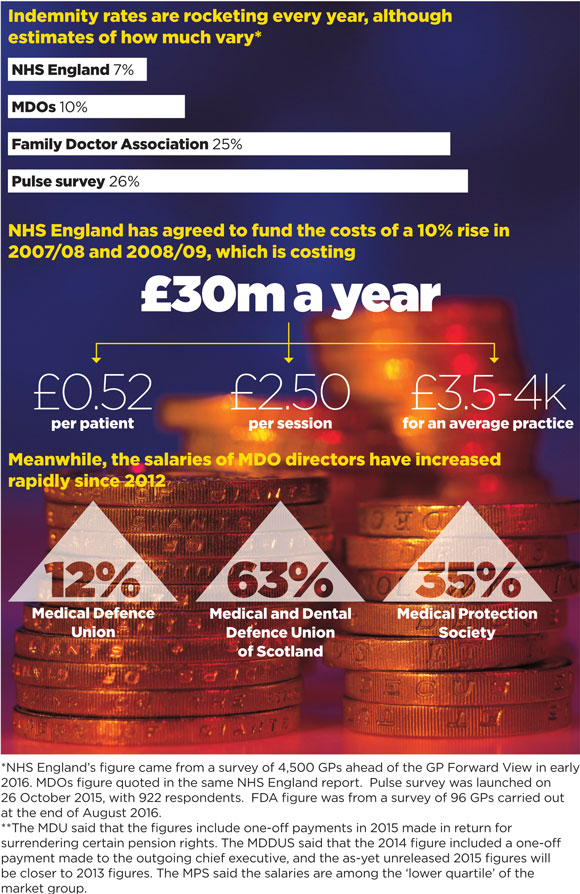Is the NHS serious about tackling GP indemnity costs?

The rampant costs of GP indemnity can no longer be ignored, and NHS England seems to have put its money where its mouth is.
In April 2017, practices can expect to receive a lump sum of around 50p per patient to cover the increase in the costs of indemnity fees, and a similar amount the following year too. NHS England has committed £30m for each of the next two years in what appears to be a tacit acknowledgement that successive pay awards have not covered soaring fees.
GP leaders have welcomed the move, but some concerns remain. First, that the extra cash won’t be enough to take the pressure off GPs, and second, that the funding will not trickle down to locum GPs who pay their own indemnity costs.
The new funding was promised in the GP Forward View in April. NHS England chief executive Simon Stevens told Pulse: ‘There’s absolutely no reason in principle why GPs should personally be on the hook for rising costs in a way that hospital doctors aren’t.’
NHS England has now said the funding will equate to some £3,500 to £4,000 annually for the average practice and will be divided among practices based on their unweighted patient list size.
Managers also said the scheme is a stop-gap while NHS England conducts a review on how to reduce fees in the long term.

indeminty infographic 580x894px
Underestimation
NHS England conducted a survey of 4,500 GPs in June that showed the average spend on indemnity had risen from £5,200 in 2010 to £7,900 in 2016 – an annual increase of 7%. In the end, managers chose to believe the medical defence organisations (MDOs), who gave a 10% annual rate of increase; this equates to around £30m per year. But a Pulse survey of more than 900 GPs earlier this year suggests those figures significantly underestimate the real increases.
It found the average reported increase last year was 26%, with some individuals quoted as much as £30,000 for annual indemnity. A smaller survey by the Family Doctor Association put the annual increase at 25% (see graphic).
However, this year, the £30m provided does come on top of money pledged in this year’s funding uplift. The 3.2% increase in the global sum this year included £33m to account for the increase in indemnity expenses.
GPC deputy chair Dr Richard Vautrey said details of how practices would receive the money are still to be negotiated, but it is likely to be a top-up payment.
He added: ‘A problem with it going into the global sum is it’s then subjected to Carr-Hill variations, so some practices get less and others more depending on their population. Yet indemnity payments really aren’t dependent on population.’
NHS England has said practices will be expected to provide an ‘appropriate share of their payment to their salaried GPs and locum GPs’. But National Association of Sessional GPs chair Dr Richard Fieldhouse told Pulse: ‘It would be really nice for the 17,000 locums out there not to have to individually negotiate and barter with practices over getting their fair share of the rise.
‘Otherwise locums are going to be charging extra for it and that’s going to increase the employer’s contributions to the NHS superannuation scheme.’
It comes as Pulse revealed the top salaries at MDOs have increased by as much as 30% since 2012. The MDOs claim the figures include one-off payments.
NHS England has also said it plans to run its winter out-of-hours indemnity scheme again. Last year the scheme saw 500 extra GPs help deliver 14,000 more shifts. However, this only covers ‘additional’ shifts, not those normally undertaken by out-of-hours GPs.
Pulse October survey
Take our July 2025 survey to potentially win £1.000 worth of tokens











